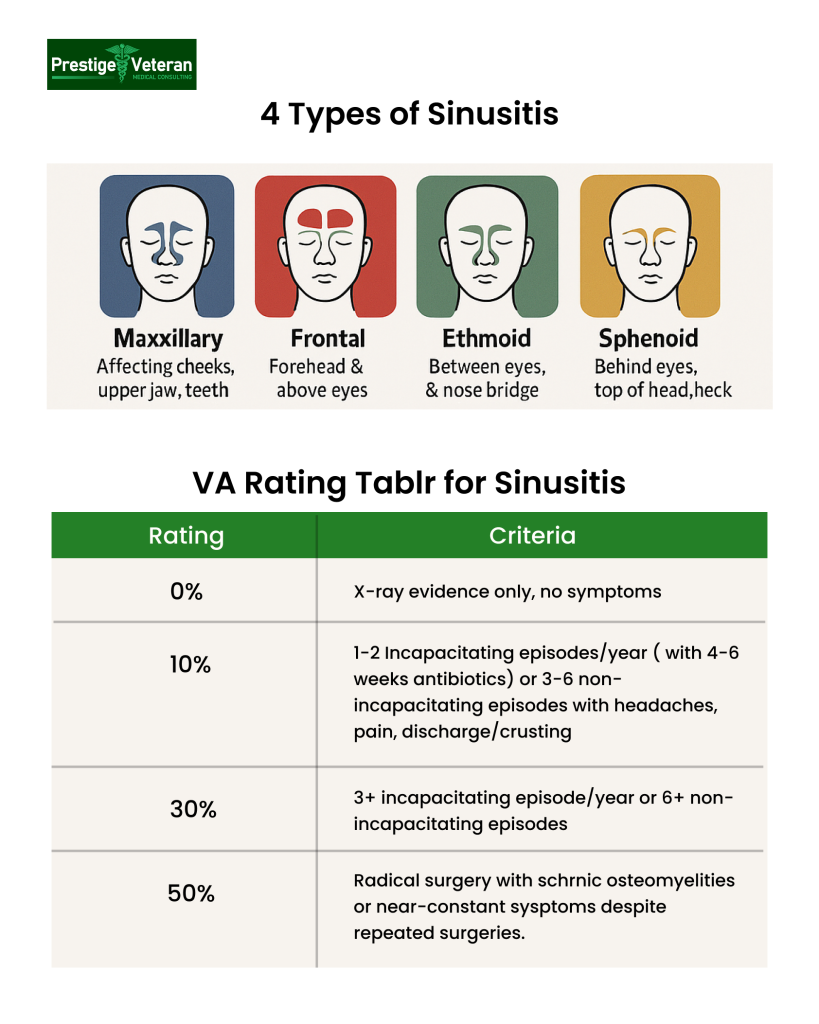Last Updated on 2 August, 2025
Living with chronic sinusitis is an ongoing health burden rooted in years of military service-related exposures to harsh environments, dust, burn-pit smoke, or desert allergens. Persistent headaches, post-nasal drip, and sleepless nights can quietly erode a veteran’s quality of life, yet these sinus symptoms often go under-documented and under-rated.
It is important to know that the Department of Veterans Affairs (VA) recognizes chronic or recurring sinus infections as compensable conditions. This detailed blog examines the sinusitis VA rating system under Diagnostic Codes 6510-6514, the claim process, and provides tips to help you secure the benefits you deserve.
Table of Contents
Sinusitis in Veterans
Sinusitis is the inflammation or swelling of the sinus cavities, which are air-filled spaces behind the forehead, cheeks, and eyes. This condition interferes with normal mucus drainage, causing congestion and pressure. A study published in the Journal of Occupational and Environmental Medicine found that veterans exposed to burn pit smoke in Iraq and Afghanistan were found to be 29% more likely to be diagnosed with sinusitis compared to those who were not deployed.
Types of Sinusitis:
- Acute Sinusitis: Temporary inflammation lasting less than 4 weeks. Acute sinusitis is often caused by viral infections like the common cold. It is the fifth most common reason for antibiotic prescriptions.
- Chronic Sinusitis: Long-term inflammation lasting more than 12 weeks, even with medical treatment. Chronic sinusitis is often caused by environmental irritants, structural abnormalities, or recurring infections.
- Recurrent Sinusitis: Repeated episodes of acute sinusitis within a year.
Common Causes of Sinusitis:
- Respiratory tract infections (bacterial, viral)
- Nasal polyps (tissue growths blocking sinus passages)
- Deviated septum (crooked nasal wall obstructing airflow)
- Allergies causing prolonged nasal inflammation
- Long-term exposure to smoke, air pollution, chemicals, or toxins
- Weakened immune systems
Military Service-Related Factors Contributing to Sinusitis:
These service-related factors may increase the risk of sinusitis among veterans.
- Sandstorms and Dust Exposure: Deployments to arid regions like the Middle East expose service members to airborne sand and fine dust particles, irritating the sinuses and increasing the risk of chronic inflammation.
- Burn Pit Exposure: Inhalation of toxic smoke from open-air burn pits, used to dispose of waste in Iraq, Afghanistan, and other combat zones, can damage the respiratory system and contribute to sinus problems.
- Chemical and Industrial Exposure: Regular contact with fuels, paints, solvents, and hazardous substances during military duties can trigger sinus irritation and inflammation.
- Facial Trauma: Injuries to the nose and facial area from blast explosions, combat, or training accidents may cause structural damage, impairing normal sinus drainage and leading to long-term sinus issues.
- Environmental Extremes: Exposure to harsh climates, pollutants, and respiratory irritants during military operations can exacerbate sinus problems and contribute to chronic sinusitis.
Symptoms of Sinusitis in Veterans:
- Nasal congestion and postnasal drip
- Headaches and facial pain
- Cough, sore throat, and bad breath
- Loss of smell and taste
- Fatigue and pressure around the eyes
- Persistent discomfort and breathing difficulties
Sinusitis is frequently linked to other service-connected conditions such as allergic rhinitis, sleep apnea, migraines, and respiratory infections, often leading to secondary VA disability claims. Veterans with traumatic brain injuries (TBI) or facial injuries may develop sinus issues as secondary conditions.
Treatment for sinusitis typically involves a combination of nasal irrigation, decongestants, corticosteroids, antibiotics (if bacterial), and, in chronic sinusitis, surgical procedures to improve sinus drainage.
Recognizing sinusitis as a service-connected disability can significantly impact a veteran’s health and quality of life, making proper evaluation and treatment essential.
VA Rating Criteria for Sinusitis Explained
The Department of Veterans Affairs (VA) rates sinusitis under 38 CFR § 4.97, Diagnostic Codes 6510-6514, covering maxillary, ethmoid, frontal, and sphenoid sinusitis.

Sinusitis is classified into four main types based on the affected sinus cavity:
- Maxillary (affecting the cheeks, upper jaw, and teeth)
- Frontal (affecting the forehead and area above the eyes)
- Ethmoid (affecting the area between the eyes and the bridge of the nose)
- Sphenoid (affecting behind the eyes, the top of the head, and the neck)
The General Rating Formula for sinusitis VA ratings is based on the severity and frequency of episodes, need for antibiotic treatment or surgery, and impact on daily life.
0% Rating: Assigned when sinusitis is detected by X-ray but causes no symptoms. This sinusitis VA rating is non-compensable, meaning the veteran is recognized as having the condition, but it does not warrant monthly compensation.
10% Rating: Given when a veteran experiences one or two incapacitating episodes per year requiring prolonged antibiotic treatment (lasting 4 to 6 weeks), or three to six non-incapacitating episodes per year with symptoms like headaches, pain, and purulent discharge or crusting.
30% Rating: Awarded when a veteran suffers from three or more incapacitating episodes annually requiring prolonged (lasting 4 to 6 weeks) antibiotic treatment, or more than six non-incapacitating episodes per year presenting with headaches, pain, and purulent discharge or crusting.
50% Rating:
The highest schedular rating for sinusitis, 50% is granted when sinusitis results in radical surgery with chronic osteomyelitis, or near-constant sinusitis characterized by headaches, pain, and tenderness of the affected sinus, and purulent discharge or crusting, despite repeated surgeries. (38 CFR § 4.97).
What is an Incapacitating Episode?
Per 38 CFR § 4.97, “An incapacitating episode of sinusitis means one that requires bed rest and treatment by a physician.” Veterans must provide documentation from medical providers to establish the frequency and severity of episodes.
The VA evaluates both the veteran’s statements and medical documentation, including physician notes, prescriptions, and treatment records, when assigning a rating for sinusitis. Additionally, secondary service connection claims for sinusitis, e.g. headaches or respiratory issues, may increase the overall disability rating.
How much compensation can I get for service-connected sinusitis?
VA monthly compensation for sinusitis depends on your disability rating. As of 2025 VA disability pay rates, the amounts are:
- 0% Rating – $0 per month (eligible for VA healthcare, but no monthly payment)
- 10% Rating – $175.51 per month
- 30% Rating – $537.43 per month
- 50% Rating – $1,102.05 per month
These amounts are for a single veteran with no dependents. VA monthly compensation may increase if you have a spouse, children, or dependent parents.
For example, a veteran rated at 30% for sinusitis receives $537.43 monthly, but with a spouse as a dependent, the payment increases to $600.33.
Proving Service Connection for Sinusitis VA Claim
Veterans seeking VA disability compensation for sinusitis must establish a service connection, demonstrating a link between the condition and military service. There are several options to file for sinusitis VA disability benefits – direct, secondary, presumptive, or aggravation of a pre-existing condition.
Direct Service Connection
Establishing a direct service connection for sinusitis requires veterans to submit evidence proving:
Current Medical Diagnosis of Sinusitis.
Documentation, including treatment records from VA or private healthcare providers. Recent imaging reports (X-rays, CT scans, or MRI results) and prescription records may help confirm a sinusitis diagnosis.
In-service event, injury, or exposure that could have caused or aggravated sinusitis when applicable.
- Service Treatment Records (STRs) documenting complaints of nasal congestion, sinus infections, or upper respiratory issues.
- DD214, former and deployment records of areas with environmental hazards (e.g., burn pits in the Gulf War or Southwest Asia, desert dust, or chemical exposure).
- Incident reports documenting specific events like chemical exposure, blast injuries, or other accidents.
Medical nexus linking the current sinusitis diagnosis to the in-service event.
An independent medical opinion from a qualified healthcare professional must state that it is “at least as likely as not” that the sinusitis was caused or worsened by military service. It is important to note that this statement can be obtained at no cost at the VA Compensation and Pension examination if the examiner agrees that the condition is related to service.
Additional Supporting Evidence
Moreover, lay statements from fellow service members or family describing sinus symptoms during or after military service can, at times, support a direct service connection claim. Post-service medical records showing continuity of symptoms can also be helpful.
Secondary Service Connection
Sinusitis often develops or worsens as a result of other service-connected conditions, including:
- Deviated Septum – A deviated septum from facial trauma can obstruct nasal airflow, leading to poor drainage and an increased risk of sinusitis.
- Nasal Polyps: These soft, noncancerous growths can form inside the nasal passages or sinuses, obstructing airflow and worsening sinus symptoms.
- Sleep Apnea – Airway obstruction in sleep apnea can cause nasal congestion and reduced airflow, contributing to sinus inflammation and infection.
- Allergic Rhinitis – Allergic rhinitis causes swelling and mucus buildup, which can block sinus openings and lead to sinusitis.
- Migraines – Sinus pressure can worsen migraines, and the inflammation associated with migraines may also aggravate sinus congestion.
- Bronchitis or Asthma – Postnasal drip from chronic inflammation due to sinusitis can irritate the lower airways, leading to respiratory conditions like bronchitis or asthma.
- Hearing Loss or Ear Infections – Chronic sinusitis can lead to Eustachian tube dysfunction, causing fluid buildup and pressure in the middle ear, which may result in hearing loss or recurrent ear infections.
- Depression and Anxiety – Prolonged sinus issues can cause poor sleep, fatigue, and discomfort, which may worsen mental health.
Filing a VA claim for sinusitis as a secondary condition requires a nexus letter clearly linking it to your primary service-connected sinusitis. For example, a pulmonologist’s opinion stating, “Your chronic sinusitis is as likely as not to aggravate your obstructive sleep apnea.”
Well-documented secondary conditions may increase your combined rating or support TDIU eligibility, so ensure all complications are properly recorded. Note that the VA doesn’t allow pyramiding (duplicate ratings for overlapping symptoms).
Burn Pit Exposure and Presumptive Service Connection
The Honoring Our PACT Act of 2022 expanded the list of presumptive conditions for veterans exposed to burn pits and airborne toxins by including chronic sinusitis. Veterans can now claim a presumptive service connection for sinusitis if they served in:
- Southwest Asia Theater of Operations (from August 2, 1990, onward): Iraq, Kuwait, Saudi Arabia, Qatar, Bahrain, Oman, Somalia, the United Arab Emirates, the Persian Gulf, and surrounding areas.
- Post-9/11 Operations (from September 19, 2001, onward): Afghanistan, Syria, Djibouti, Jordan, Lebanon, Yemen, or Uzbekistan.
Sinusitis is now presumed service-connected if it manifests within 10 years of separation from military service. This means veterans need only demonstrate qualifying service in these regions; they do not need to prove a direct link (nexus) between their sinusitis and military service if adjudicators agree that they meet this criterion.
Under the PACT Act, the VA presumes exposure to particulate matter and toxins, based on scientific evidence reviewed by the VA and the National Academies of Sciences, Engineering, and Medicine (NASEM).
This presumption especially benefits veterans with sinusitis or rhinitis whose claims were previously denied due to a lack of exposure proof, simplifying their path to obtaining VA compensation.
Service Connection by Aggravation
If sinusitis existed before military service but worsened during active duty, veterans may qualify for VA disability benefits based on aggravation. To establish this, medical evidence must demonstrate that the sinusitis progressed beyond its natural course due to military service. This often applies to veterans with pre-service nasal conditions or childhood allergies who later faced exposure to environmental toxins or facial injuries.
For an aggravated sinusitis rating, the VA first assesses the severity of the condition at enlistment. It then assigns a new disability rating based on how much the condition worsened as a result of military service.
For example, a veteran had mild asthma rated at 10% before enlistment. After deployment, burn pit exposure worsened their asthma, requiring daily medication. The VA assigns a new rating of 60% for the aggravated condition but subtracts the original 10%, resulting in a final rating of 50%.
Total Disability Individual Unemployability (TDIU) and Sinusitis
While sinusitis alone rarely qualifies for TDIU, it can contribute to a combined rating that prevents you from working. If your sinusitis, combined with other service-connected disabilities, prevents you from maintaining substantially gainful employment, you may qualify for TDIU benefits, which pay at the 100% disability rate.
TDIU Requirements:
- One disability rated at least 60%, OR
- Two or more disabilities with a combined rating of at least 70%, with one rated at least 40%.
If your VA sinusitis rating is 50% and you also suffer from sleep apnea, migraines secondary to sinusitis, or other service-connected conditions, you might meet the combined criteria for TDIU.
Buddy Statements and Lay Evidence
In VA claims involving sinusitis, personal statements from veterans and buddy letters from fellow service members, family members, or friends can fill gaps in medical records, especially when exposure is hard to prove. These firsthand accounts can describe exposures, confirm symptom onset during military service, and explain how sinusitis affects the veteran’s daily life.
Combining strong medical records, nexus opinions, and credible buddy statements offers veterans the best chance of proving service connection for sinusitis and securing the VA benefits they deserve.
Difference Between Rhinitis vs. Sinusitis in VA Claims
While rhinitis and sinusitis both involve inflammation in the nasal region, they affect different anatomical areas and are evaluated separately by the VA. Rhinitis, rated under VA Diagnostic Code (DC) 6522, affects the nasal mucosa and typically causes symptoms such as sneezing, itching, clear nasal discharge, and nasal congestion. The maximum VA rating for rhinitis is 30%, which requires the presence of nasal polyps and without polyps, the rating is capped at 10%.
Sinusitis, on the other hand, is rated under Diagnostic Codes 6510–6514 and involves inflammation of the sinus cavities, like the maxillary, frontal, ethmoid, or sphenoid sinuses. It often presents with symptoms like purulent nasal discharge, facial pain or pressure, crusting, and sometimes polyps. Severe cases may require systemic medications and periods of bed rest.
| Category | Rhinitis | Sinusitis |
| Definition | Inflammation of the nasal mucosa | Inflammation or infection of the sinus cavities |
| Common Causes | Allergies, irritants (e.g., dust, pollen, smoke) | Infections, structural blockages, environmental exposure |
| Primary Symptoms | Sneezing, itching, nasal congestion, clear discharge | Facial pain/pressure, purulent discharge, post-nasal drip, fever |
| VA Diagnostic Code (DC) | DC 6522 (Allergic) / DC 6523 (Bacterial) | DC 6510–6514 (based on sinus cavity affected) |
| Rating Criteria | 10% (without polyps), 30% (with polyps) | 0%, 10%, 30%, 50%, based on frequency/severity of incapacitating episodes |
| Nasal Polyps | Required for 30% rating under DC 6522 | May occur, but not required for rating |
Although rhinitis and sinusitis can share overlapping symptoms, such as congestion or post-nasal drip, the VA grants only one rating to avoid “pyramiding” or rating the same symptom under multiple diagnoses. However, if each condition presents distinct symptoms (e.g., allergic rhinitis with sneezing vs. sinusitis with purulence), veterans may qualify for separate ratings.
Veterans should provide clear medical evidence showing both sinusitis and rhinitis are distinct, chronic, and documented in their service records. Those exposed to burn pits under the PACT Act should include a detailed DBQ and a clear nexus letter to strengthen their VA disability claim.
You can read the M21-1 Adjudication Procedures Manual to understand how the VA rates Chronic Sinusitis and Rhinitis together.
How to File a VA Disability Claim for Sinusitis
Filing a VA disability claim for sinusitis involves several key steps to ensure your application is thorough and accurate.
- Gather Info: Consider following the guidelines outlined on VA.gov or connect with an accredited VA representative like a VSO, Accredited Claims Officer, or an attorney for assistance.
- Gather Medical Records – Collect all relevant medical records that diagnose and show treatment for sinusitis, including:
- Military service treatment records
- Post-service medical documents
- Doctor’s reports and prescriptions
- Imaging results (e.g., CT scans or X-rays)
- Nexus letters from ENT specialist or physician
- Provide a Nexus Statement (optional) – An effective Nexus letter should clearly explain how your sinusitis is connected to your military service. This can be written by a VA doctor, a private healthcare provider, or an independent medical opinion provider.
- File Your VA Disability Claim – You can submit your sinusitis disability claim online via the VA website, by mail using VA Form 21-526EZ, or in person at a VA regional office. Consider working with a Veterans Service Organization (VSO) representative for assistance.
- Submit Supporting Evidence – Along with the application, provide evidence such as a completed sinusitis DBQ form, buddy statements, audiograms if deafness is involved, and any other supporting documentation for your VA claim.
- Attend a C&P Exam – After filing, the VA may schedule a Compensation and Pension (C&P) exam. This medical evaluation assesses the severity and connection of your sinusitis to military service. Be honest and detailed about your symptoms.
- Await VA’s Decision – The VA reviews your claim, medical evidence, and exam results. This process can take months. Once completed, the VA will notify you of its decision and assigned disability rating.
Staying organized and proactively submitting necessary evidence improves your chances of receiving the benefits you deserve.
What Happens in a C&P Exam for Sinusitis?
A Compensation and Pension (C&P) exam for sinusitis is an important step in the VA disability claims process, designed to assess your condition and its connection to your military service.
- Review of Medical History: During the C&P exam, the examiner will carefully review your medical history, including any past treatments, diagnoses, and imaging studies. You’ll discuss when your sinus problems first began and whether they were influenced by your service, such as exposure to burn pits, dust, or other environmental hazards.
- Discussion of Symptoms: Be prepared to describe your symptoms in detail—nasal congestion, facial pressure, headaches, or frequent infections and explain how often these flare-ups occur, especially if they’ve required antibiotics or left you bedridden.
- Physical Examination: The C&P examiner will likely perform a physical evaluation, checking your nasal passages for swelling or blockages and feeling your sinuses for tenderness. If you report sinus deafness, you may undergo an audiogram.
- Impact on Daily Life: During your sinusitis C&P exam, the examiner may ask how sinusitis interferes with your work, sleep, and daily routine. Be open and specific about your struggles. Mention missed work, fatigue, or how pain disrupts simple tasks.
The information gathered will be recorded on a Disability Benefits Questionnaire (DBQ) for sinusitis, helping the VA accurately determine your disability rating based on the severity and impact of your condition.
How a Nexus Letter Can Enhance Your VA Claim for Chronic Sinusitis
A medical nexus letter can be a powerful asset in a veteran’s VA disability claim for sinusitis, especially when it clearly links the condition to military service or toxic exposure.
To improve the chances of securing a favorable VA rating, the nexus letter should include:
- Detailed medical evidence, such as the frequency and severity of symptoms
- History of sinus infections
- Documentation of chronic inflammation supported by treatment records
Example of a Nexus Opinion
For instance, a strong nexus statement might read: “It is at least as likely as not (a 50% or greater probability) that the veteran’s chronic sinusitis is linked to prolonged exposure to burn pits and environmental toxins during deployment to Iraq from 2007–2008. Service treatment records show repeated visits for sinus issues, including persistent congestion and multiple courses of antibiotics, consistent with VA rating criteria.”
The VA assigns sinusitis ratings of 10%, 30%, or 50%, based on the number of incapacitating episodes, antibiotic usage, and symptom severity. A nexus letter should directly reference this information, such as noting five antibiotic treatments in a year and a significant disruption to daily life, to support a higher sinusitis VA rating.
Even if presumptive service connection applies, a nexus letter remains essential when exposures fall outside the VA PACT Act criteria or when additional medical backing is needed. Paired with imaging and a completed DBQ sinusitis form, a nexus letter can turn a weak claim into a strong approval.
Tips for Increasing Your Sinusitis VA Rating
If you believe your current VA disability rating for sinusitis does not reflect the full extent of your condition, there are steps you can take to pursue an increase. Here are some important considerations to help ensure your chronic sinusitis VA rating accurately represents your health limitations:
1. Maintain a Detailed Symptom Diary
- Track your daily experiences with sinusitis.
- Record the frequency and duration of incapacitating episodes, such as those requiring prolonged antibiotic treatment, bed rest, or medical care.
- Note non-incapacitating flare-ups with headaches, facial pain, and nasal discharge.
- Document missed workdays and any disruptions to daily functioning.
This ongoing record provides concrete evidence to support your claim for a higher sinusitis VA rating.
2. Seek a Re-Evaluation When Symptoms Worsen
If your sinusitis has become more severe since your initial rating, you can request an increased rating by utilizing a VA Form 21-526EZ. Provide updated medical records showing more frequent treatment, longer antibiotic use, or surgical interventions when applicable. A Compensation & Pension (C&P) exam may be scheduled, where your symptom log and records can reinforce your case.
3. Prepare Thoroughly for Your C&P Exam
Prepare well for your C&P exam by clearly explaining how sinusitis affects your daily life. Talk about symptoms, flare-ups, and any challenges at work or home. Be honest and specific, helping the VA understand the full impact. Providing detailed but concise answers can help ensure an accurate and potentially increased sinusitis VA rating.
4. Understand the Role of Secondary Conditions
Sinusitis often contributes to secondary conditions like sleep apnea, migraines, bronchitis, rhinitis, or laryngitis. If diagnosed, these secondary disabilities can raise your combined rating or lead to eligibility for Total Disability Individual Unemployability (TDIU).
While establishing a link requires medical evidence, showing the broader impact of sinusitis on your health can significantly increase your overall VA compensation.
5. Learn How VA Combines Ratings
Veterans Benefits Administration (VBA) does not simply add ratings together. Instead, they use the VA Combined Ratings Table. For example, a 50% rating for sinusitis and a 30% rating for sleep apnea results in a combined 65%, rounded to 70%. Understanding this system is key to estimating your potential combined disability rating.
6. Obtain a Nexus Opinion
Consider obtaining an Independent Medical Opinion (IMO) from a qualified medical professional, depending on your circumstances. An IMO can provide a detailed evaluation of your condition and clarify its impact on your daily life. A well-supported nexus letter can often be a decisive factor in securing a higher rating.
Prestige Veteran specializes in helping veterans strengthen their VA disability claims through expert medical nexus letters.
7. Gather Supporting Evidence
The additional evidence can help in maximizing your sinusitis VA rating:
- Medical documentation including diagnostic tests, CT scans or imaging results, antibiotic prescriptions, and nexus letter opinions
- A Disability Benefits Questionnaire (DBQ) completed by your doctor
- Lay statements from family members, coworkers, and employers verifying the functional and psychological impact of the sinusitis
- Proof of missed work and reduced quality of life
If you’re uncertain about the process or feel overwhelmed, seek legal assistance from VA-accredited attorneys or veterans’ advocates.
Appealing a Denied Sinusitis VA Claim
If your VA sinusitis claim was denied or received a low rating, start by reviewing the VA decision and identifying gaps in evidence or errors. Once you understand the decision, you have three main options to challenge the decision according to the VA’s Appeals Modernization Act:
- Supplemental Claim: Submit new and relevant evidence to support your appeal case.
- Higher-Level Review: Request a senior VA reviewer to reassess your claim without submitting new evidence.
- Board Appeal: Take your case to the Board of Veterans’ Appeals, where a Veterans Law Judge will review your sinusitis disability claim.
Each option has different timelines and requirements, so carefully choose the best approach based on your situation. Consulting a VA-accredited representative, claims agent, or Veterans Service Organizations (VSOs) can improve your chances of a successful appeal.
Real-Life Example: Securing an Increased VA Rating
A 40-year-old Army veteran has struggled with chronic sinusitis since his deployment in Iraq. His sinusitis VA rating was 10%, but his symptoms worsened—frequent sinus infections, severe headaches, and breathing issues requiring antibiotics monthly.
Determined to secure a fair rating, he submitted new medical evidence, a sinus CT scan showing nasal obstruction, and a crucial nexus letter from his ENT specialist linking his condition to service. With professional support, the veteran’s rating increased to 30%, reflecting his condition’s severity, finally securing the VA compensation he deserved.
Conclusion
Securing a VA disability rating for sinusitis can significantly improve a veteran’s quality of life by providing essential benefits and compensation. Understanding the VA rating for sinusitis, the importance of medical evidence, and how to prove a service connection is crucial for a successful claim. Whether filing an initial claim, seeking an increased rating, or appealing a denial, proper documentation and expert guidance can maximize your benefits. Veterans suffering from sinusitis should pursue the compensation they rightfully deserve.
FAQs
How much is a chronic sinusitis VA disability rating?
The VA rates sinusitis under Diagnostic Codes 6510-6514, with ratings of 0%, 10%, 30%, and 50%, based on the frequency, severity of symptoms, impact on daily functioning, and need for prolonged antibiotic treatment or surgery.
Does the VA require an examination to evaluate chronic sinusitis?
Yes, the VA may schedule a Compensation and Pension (C&P) examination to assess both the severity and service connection of chronic sinusitis.
How to prove a sinusitis VA claim?
Proving VA disability for sinusitis isn’t necessarily hard if you have a current diagnosis, service connection proof (or presumptive exposure), medical records, and ideally a nexus letter linking your condition to military service.
What are the top symptoms of chronic sinusitis?
Chronic sinusitis symptoms include nasal congestion, facial pain or pressure, postnasal drip, headaches, and persistent fatigue.
When did sinusitis become presumptive?
Sinusitis became a presumptive condition under the PACT Act of 2022 for veterans exposed to burn pits and toxins in Southwest Asia and post-9/11 operations. Some circumstances also predated this.
What is the highest VA disability rating for sinusitis?
The highest VA disability rating for sinusitis is 50%, assigned for near-constant sinusitis characterized by pain, headaches, and purulent discharge or crusting after repeated surgeries.
What is the 30% rating for sinusitis?
A 30% sinusitis VA rating is assigned when veterans experience three or more incapacitating episodes per year or over six non-incapacitating episodes with pain, discharge, or crusting.
What is the difference between rhinitis and sinusitis, VA?
Rhinitis affects the nasal mucosa and is rated under DC 6522, while sinusitis involves sinus cavity inflammation and is rated under DC 6510–6514 based on severity and episode frequency.
How does the VA rate sinusitis and rhinitis together?
The VA rates sinusitis and rhinitis separately only if each condition causes distinct, non-overlapping symptoms to avoid pyramiding under VA regulations.
Also read: How to Obtain a Nexus Letter for a VA Claim?
At Prestige Veteran Medical Consulting, a veteran-owned company, we specialize in Independent Medical Opinions (IMOs) known as Nexus letters.
Our purpose is to empower YOU, the veteran, to take charge of your medical evidence and provide you with valuable educational tools and research to guide you on your journey.
Understanding the unique challenges veterans face, our commitment lies in delivering exceptional service and support.
Leveraging an extensive network of licensed independent medical professionals, all well-versed in the medical professional aspects of the VA claims process, we review the necessary medical evidence to incorporate in our reports related to your VA Disability Claim.
Prestige Veteran Medical Consulting is not a law firm, accredited claims agent, or affiliated with the Veterans Administration or Veterans Services Organizations. However, we are happy to discuss your case with your accredited VA legal professional.













